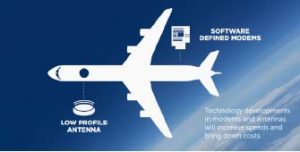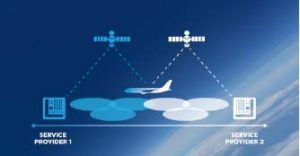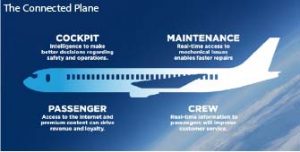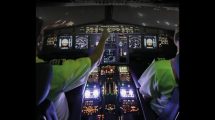 To say that passenger expectations for in-flight connectivity have increased would be an understatement. No longer content with cheap, wired headphones, today’s passengers consider inflight connectivity a must-have, and it increasingly guides their decision on what airline to fly.
To say that passenger expectations for in-flight connectivity have increased would be an understatement. No longer content with cheap, wired headphones, today’s passengers consider inflight connectivity a must-have, and it increasingly guides their decision on what airline to fly.
According to the 2016 SITA Airline IT Trends Survey, 97 percent of passengers now carry Internet-capable devices while travelling. And, as many as one in four of these tech-savvy customers choose to fly with one airline over another simply based on Wi-Fi availability.
Yet, uptake has been slow for paid service and there are several contributing factors. Data rates in the sky don’t match rates on the ground. Many passengers believe that Internet service is a basic right and should also be offered for free – just like in hotels and cafes.
This situation has airlines looking for ways to secure business value from their networks – rethinking the financial formula for in-flight connectivity.
Today, airlines are also moving beyond an exclusive focus on the customer entertainment, connecting the entire aircraft to enable digital applications and connect to operations on the ground.
 “Fully connected” now means cockpits with electronic flight bags to improve aircraft operations. It means increasing communication between the crew, cockpit, and ground maintenance teams to allow for better predictive aircraft management and repairs.
“Fully connected” now means cockpits with electronic flight bags to improve aircraft operations. It means increasing communication between the crew, cockpit, and ground maintenance teams to allow for better predictive aircraft management and repairs.
It means equipping cabin crews with the latest mobile technology to improve customer care, increase on-board credit card transactions, and offer real-time authentication to help reduce fraud, all of which lead to increased revenue. And of course, it means high-speed connectivity and premium content to satisfy passenger demands. The new vision of the “connected aircraft” presents an even greater network challenge for airlines. It equates to managing a global wireless network in the sky that serves a much broader suite of applications and end-users, all of which are vying for contested bandwidth. Now is the time for airlines to begin implementing new innovation.
Creating the Business Case for In-Flight Connectivity
When evaluating the proper communications solution, airlines need to consider their long-term plans for a broad range of applications across their fleet and service territory.
 Passenger Connectivity
Passenger Connectivity
The growth of smart phones and tablet devices are creating an environment where many passengers want to use their own technology to stay connected for either work or social reasons. This includes streaming video, voice connectivity and online activities, such as email and social media.
Crew Solutions
With connectivity onboard, airline crew can take customer service to new heights. They can enhance the experience by knowing the travel history and details of particular passengers or let passengers select meal preferences electronically. They can better check on the status of connecting flights or checked baggage before landing and provide hotel bookings if passengers experience travel delays.
Flight Operations
Cockpit Services Electronic Flight Bag (EFB) systems provide pilots with a suite of applications designed to provide greater insight into the performance of their flight. When connected, EFB systems can better provide real-time information, including dynamic charts, weather updates and navigation tools that provide better insight and improve situational awareness for the pilot. These capabilities also enable a pilot to share operational details about the plane with aircraft support personnel and technicians on the ground. Data tracking enable airlines to make decisions in real time to improve aircraft operations and reduce operating costs.
Maintenance Applications
With in-flight connectivity, sensors on aircraft can monitor aircraft health through engine management, or critical system functionality, along with measuring other parameters like speed, altitude and fuel consumption. These systems can alert ground crew of maintenance issues prior to landing. This will help ensure that maintenance can be addressed as soon as the plane reaches the gate, for quick turnaround.
Leverage High-Speed Capacity
The most critical challenge today is the need for higher throughput connectivity to the plane. The emerging solution is High Throughput Satellites (HTS) which delivers increased data rates to passengers and lowers the airlines cost per bit.
NSR predicts that HTS and Ku band VSAT networks will overtake Air-to-Ground (ATG) systems as the dominant mode of in-flight connectivity. ATG will decrease from a 73 percent market share in 2014 to 35 percent in 2024. HTS will rise from 3 percent to 33 percent market share in the same period. By 2025, NSR estimates 18,000 aircraft will be powered by HTS, adding up to $2.8 billion in potential revenue.
Improve Service Levels
Speed, by itself, is only part of the equation. Combining HTS with mobility applications presents a major challenge when it comes to managing complex Service Level Agreements (SLAs). The increased capacity available through HTS can mean very little unless you can increase the quality of the end-user experience.
 It is becoming increasingly difficult to manage bandwidth across a contended network that spans multiple beams, aircraft and end users. At any given moment, there are thousands of aircraft operating around the globe, with each one needing to connect to various bandwidth levels over the course of their journey. Even with faster modem speeds, bottlenecks can occur if network traffic is not prioritised correctly.
It is becoming increasingly difficult to manage bandwidth across a contended network that spans multiple beams, aircraft and end users. At any given moment, there are thousands of aircraft operating around the globe, with each one needing to connect to various bandwidth levels over the course of their journey. Even with faster modem speeds, bottlenecks can occur if network traffic is not prioritised correctly.
Those operating aero VSAT networks need to expand their thinking from what data rate is being delivered on an individual airplane to how do they source, integrate and manage a global pool of bandwidth. They need a global bandwidth and network management system that allows them to pool satellite capacity across numerous spot beams and create group service plans that can automatically allocate resources as they are needed.
Airlines can manage the use of bandwidth across an airline’s entire fleet to prioritise service levels based on multiple criteria, including bandwidth profiles for individual aircraft or even specific onboard applications. Without such a measure in place, an airline operator or service provider may need to over-allocate dedicated bandwidth to each application to ensure an acceptable quality of service.
High-Speed Beam Switching
Another key requirement to providing the optimal customer experience is automatic beam selection and fast-beam switching. To ensure seamless connectivity, an aircraft must now be able to automatically switch between satellite beams as it moves from one geographic footprint to the next with no manual intervention across multiple satellite footprints in a high-speed environment. Internet sessions should not be interrupted as the plane moves through several beams on a flight.
 Adopt Multi-Provider Roaming
Adopt Multi-Provider Roaming
Regional service providers catering to airlines will need to adopt roaming to expand service reach outside of their core networks. Mobile operators have mature architectures that enable a customer to roam from a home network to a guest network while maintaining home service plans. The satellite industry is developing similar capabilities whereby a satellite service provider may partner with other service providers to enable their mobility terminal to roam between autonomous networks. Service providers adopting these business and technical models will maximise capital and operational resources. The roaming technology itself can evolve into multiple forms – roaming from a service provider’s regional coverage to another, or roaming from a GEO constellation into a LEO/MEO constellation.
Bringing Smarter Technology On-board
A major area of improvement for in-flight connectivity encompasses onboard satellite equipment. From in a high-speed environment. Internet sessions should not be interrupted as the plane moves through several beams on a flight.
Adopt Multi-Provider
Roaming Regional service providers catering to airlines will need to adopt roaming to expand service reach outside of their core networks. Mobile operators have mature architectures that enable a customer to roam from a home network to a guest network while maintaining home service plans. The satellite industry is developing similar capabilities whereby a satellite service provider may partner with other service providers to enable their mobility terminal to roam between autonomous networks. Service providers adopting these business and technical models will maximise capital and operational resources. The roaming technology itself can evolve into multiple forms – roaming from a service provider’s regional coverage to another, or roaming from a GEO constellation into a LEO/MEO constellation.
Bringing Smarter Technology On-board
A major area of improvement for in-flight connectivity encompasses onboard satellite equipment. From ensure constant satellite connection.
Powerful Software-Defined Modems
Swapping out on-board equipment is a considerable logistical and regulatory challenge. It can take several years for a regulatory body to approve new hardware to be installed inside an airplane, even longer if it requires installation of new antennas or anything mounted to the frame structure of the airplane.
Today, airlines can adopt a remote solution that’s engineered with a high degree of flexibility to adapt to changing requirements while only paying for the capabilities that they really need at any given time. Through software-defined and reprogrammable remote architectures, this next-generation of remotes can be continually upgraded over-the-air to increase network capabilities and throughput levels, while dramatically extending the deployment life in the air.
This software-defined architecture also allows to incorporate support for other waveforms in the future whether for working more efficiently on different GEO HTS satellites or different orbits such as MEO and LEO altogether.
Source: iDirect














Add Comment